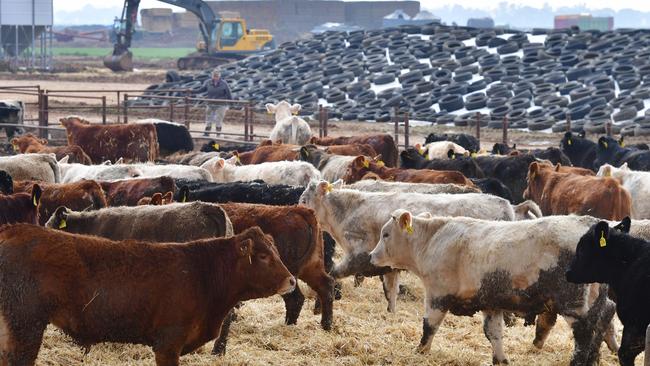‘They’re proving essential in finishing cattle during dry and drought-affected periods’
One factor keeping cattle prices from collapsing despite big yardings is feedlots, with Australia’s grain-fed industry hitting new highs.
Dry conditions across much of southeastern Australia have helped feedlot numbers to climb to record levels.
At the end of March, 1.497 million cattle were on feed, the highest national number ever, while feedlot utilisation at 90 per cent was also a record rate.
Meat and Livestock Australia senior market information analyst Erin Lukey said feedlots had been able to draw cattle from southern Australia to keep their numbers up, given good conditions across much of Queensland.
She said strong global demand and stable margins had also lifted confidence in the feedlot sector.
“Feeder (steer) prices lifted across most states, despite an increase in cattle supply,” Ms Lukey said.
“Darling Downs wheat prices also increased in the March quarter, lifting 3 per cent to $341/tonne, however this is nearly 10 per cent below year-ago levels.
“An annual lift of 9 per cent in steer price combined with a 10 per cent reduction in the feed (wheat) price reflects a relatively stable system, supporting lot feeder margins.”

The feedlot survey results, announced last week, come as Australia posted record exports of grain-fed beef in April, with 37,037 tonnes sent offshore with 33 per cent going to China.
Most cattle are held in feedlots of more than 10,000 with more than 1 million in the larger scale operations.
About 423,000 of the cattle are in feedlots ranging in size from 1000-10,000 and at the other end of the scale, about 48,000 are in facilities that hold less than 1000.
Australian Lot Feeders Association president Grant Garey, said the variable weather conditions in the past year had “highlighted the versatility of the Australian lot feeding sector and its vital role in supporting national food security”.
“Australian feedlots continue to lift productivity, delivering high-value grain-fed beef to meet strong global demand,” Mr Garey said.
“At the same time, they’re proving essential in finishing cattle during dry and drought-affected periods, reinforcing their importance in a resilient supply chain.”
Mr Garey said this was seen in feedlot utilisation lifting in South Australia and Victoria, with the latter at 93 per cent, its highest since the 2019 drought.
“Southern feedlots have adapted their finishing programs, enabling fast turnover of cattle, while in the north, growing international demand for grain-fed beef is driving system-wide productivity gains,” he said
“The lot feeding sector is critical to ensuring consistent production of high-quality beef, regardless of seasonal conditions.”
At the end of March, Queensland had 851,190 cattle on feed to be the biggest feedlot state. NSW came in second with 442,735, South Australia third with 71,060 and Victoria fourth 69,613.




